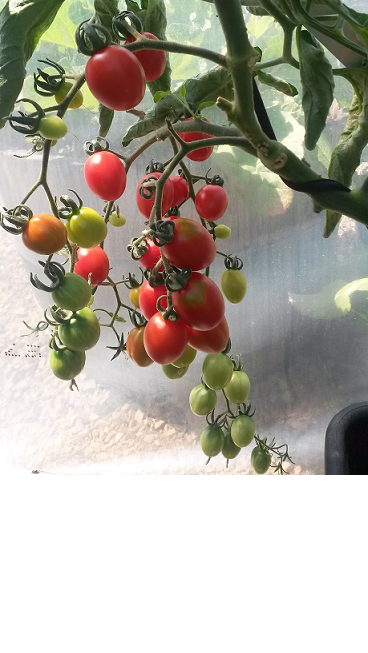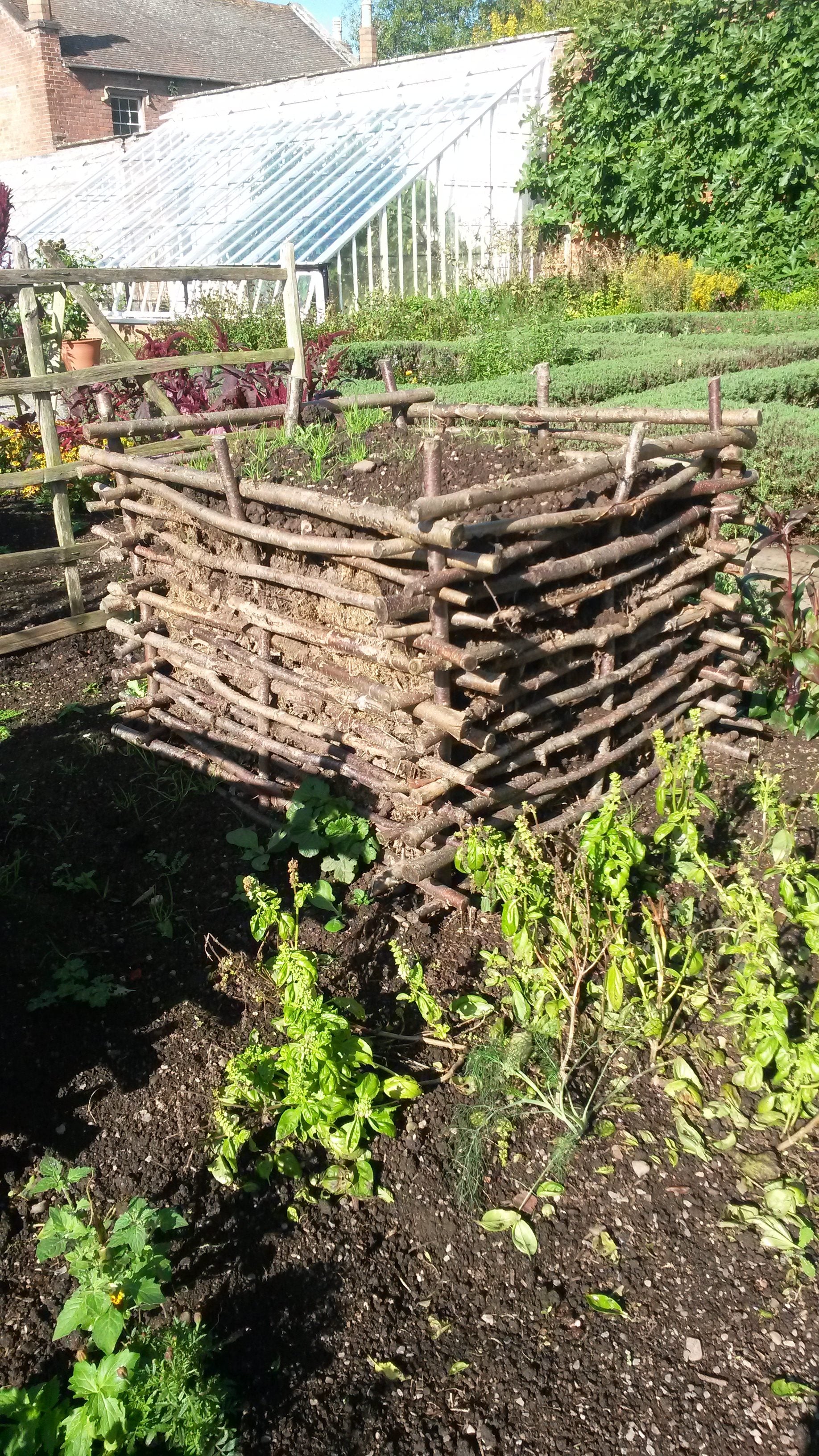 Essential Water
Essential Water
When I first started writing this, the sky had opened and the rain was falling ... at last. Actually it was so misty outside I couldn't see the top of our hill. After the winter rain and then months of dry I will certainly be more considered with my wishful thinking. Today the sun is once again shinning and the garden looks like it needs water again.
When to water?
Heather and I were talking the other day about the best time of day to water. I’have always watered in the early morning and Heather likes to water in the evening. We both agreed that mid-day was a waste of water because of the evaporation and water sitting on the leaves is potentially harmful to the plants.
My early morning watering is a hang over from getting up early to be in the greenhouse before the heat of the day. It’s a beautiful peaceful time to potter before the day gets busy and I generally plan the rest of my day. I always worry when I water at night that the powdery mildew and other fungal pests will thrive on the damp leaves.

Heather got me thinking about what is best for the plants. Her reasoning was around allowing time for the water to soak into the soil and avoid evaporation. The plants have time replenish their stores again over night. This makes them more resistant to the environmental factors thrown at them during the day.
Then There is the in between where it is recommend to water in ground plants in the morning and container gardens in the afternoon. If using containers it is important to ensure your containers hold the water. Glazed terracotta pots and plastic pots hold the water. Terracotta pots are renown for leaching the water leaving less water available for the plant.
How to water?
It's best to get the water to the base of the plant. When you water make sure you water deep so that the percentage lost to evaporation is smaller. It is better to soak the soil around the plant and then not water for a few days than shallow water every day. A deep soak encourages the roots to grow deep and buffers the water loss from the surface of the soil.
I always try to avoid getting too much water on the plants leaves. Again this is due to the heat in the greenhouse. If you avoid the leaves you can stop water sitting on the leaves and causing brown spots due to hot water as the temperature rises.
Installing watering solutions can help. Products like our
Autopot Spyder or plant drippers deliver the water exactly where it is needed.
Water conservation techniques in the garden
If you haven't already, add a rain barrel to your downpipe and collect your rain water for the garden.
Mulching the garden is the best way to conserve water. Not only does it save water it also stops the weeds and feeds the soil. The poultry compost makes a great mulch and will improve the soil. Currently it is $12 per bag or $30 for three bags.
Plant your plants in blocks rather than rows. It's easier to water a block and closer planting, if possible, will stop some water evaporating from between the rows. Group plants by water needs - some plants are more tolerant and can be skipped when deciding on a watering schedule.
Use compost in the soil. The more humus rich your soil is the more water it will retain. Especially here on the coast the soil is quite sandy and doesn't hold the water well. Consider adding compost to retain that precious moistu

re.
Check your hose fittings. So much water is wasted with hose fittings that are worn. How many of us have that hose fitting that leaks when inserted into the tap clip-on? We'll get around to fixing it but it never seems to get off the to do list. It is often a simple matter of just replacing the rubber ring on the end of the clip-on. Every drop counts.
If you're using containers try puting a thin layer of gravel or clay balls on the top. This acts like a mulch layer and can reduce the evaporation from the potting mix.
Any other ideas you have for water conservation we'd love to hear them.
 Autopot News
Autopot News
Our Autopots continue to increase in popularity especially with the drought we have had this spring / summer. The Autopot is great for water conservation as it has no exposed water surfaces for evaporation but the plant readily has all it needs. The results speak for themselves.
Gravity feed self-watering
The Autopots are not restricted to hydroponics. We have successfully grown in a potting mix / clay ball mixtu

re with just water in the tank. We tried just straight potting mix but found the potting mix compacted too much. We now add clay balls to the mix. The clay balls lighten the mixture without loosing the water retention and give the roots more air. They're also reusable. Once the plant is finished you can wash them, sterilize them in janola, rinse and reuse. When you wash them it can be difficult to separate the soil from the balls. I have found if you wash them in a wheelbarrow, then spread them out thinly and let them dry, you can sweep them off the soil.
We also have a dwarf apple tree and a lemon tree in the XL pot. When we transplanted the lemon from the garden into the pot because I wanted the garden bed for the Autopot Spyder, I wasn't sure it would survive. I expected it to sulk and drop all it's leaves but it proved me wrong and has new shoots, flowers and fruit forming.
I think I'm only bound by my imagination when it comes to this watering system.
 Heathers Corner
Heathers Corner
Happy New Year everyone. I hope you are having success with your gardens as we are here. We’re picking beans daily now, along with tomatoes, spring onions, basil and lettuces. In spite of the wind, the garden stood up well and the beautiful warm rain has been a perfect follow up. Things are looking good. It’s been so nice not having to constantly water the garden; the rain does it so much better for some reason.
Our hanging baskets with petunias were looking decidedly lanky and mildewy before Christmas so we cut them right back, fed them with Mr Bloom to encourage them to re flower and, hey presto, they were looking good when we came back after Christmas. So don’t give up on tired looking baskets, annuals are so easy to rejuvenate.
We’re hoping we’ll be able to give our hothouse plants a second chance after their rough treatment in the weekend. Some of the tomatoes have gone as they were broken but the others, although not looking their best, may possibly make it. Autopots give them the best chance because their requirements with water and food are being met when they need it.
Have you all got glut of zucchini? The weirdest recipe I found for them is ...
Courgette Lemon Curd!
8 cups diced courgette (preferably yellow but peel the green ones if using them)
1 kg sugar
125 grams butter
3 lemons, juice and zest
Steam courgette until tender then process until creamy, add to the rest of the ingredients and bring to a rolling boil and cook until glossy. Pour into hot jars and seal.
They reckon it will fool the kids, but I doubt it!!
Summer garden rewards
Pickles, chutney, jams and preserves. I love this time of year. The rewards for all the hard work planting and caring for the garden truly come home when you start preserving the yields from the garden.
The Tomatillo that we grew because a customer said they were great have turned out to be a top performer this year and I will definitely grow them again next year. The green Tomatillo salsa I have made has been a great hit.
 Not so much fun
Not so much fun
Last Friday night we had some unwanted visitors. It was a hard way to find out that the security alarm system was not working correctly.
It was incredibly heart breaking to find all our hard work and glorious plants upended in a heap in the middle of the green house. It is the time of year where we were beginning to enjoy the fruits of the last 5 months tending the tomatoes, cucumbers and chili.
Needless to say the alarm is now working correctly and I hope to never have to face a cleanup like that again.

 Essential Water
Essential Water Heather got me thinking about what is best for the plants. Her reasoning was around allowing time for the water to soak into the soil and avoid evaporation. The plants have time replenish their stores again over night. This makes them more resistant to the environmental factors thrown at them during the day.
Then There is the in between where it is recommend to water in ground plants in the morning and container gardens in the afternoon. If using containers it is important to ensure your containers hold the water. Glazed terracotta pots and plastic pots hold the water. Terracotta pots are renown for leaching the water leaving less water available for the plant.
Heather got me thinking about what is best for the plants. Her reasoning was around allowing time for the water to soak into the soil and avoid evaporation. The plants have time replenish their stores again over night. This makes them more resistant to the environmental factors thrown at them during the day.
Then There is the in between where it is recommend to water in ground plants in the morning and container gardens in the afternoon. If using containers it is important to ensure your containers hold the water. Glazed terracotta pots and plastic pots hold the water. Terracotta pots are renown for leaching the water leaving less water available for the plant.
 re.
Check your hose fittings. So much water is wasted with hose fittings that are worn. How many of us have that hose fitting that leaks when inserted into the tap clip-on? We'll get around to fixing it but it never seems to get off the to do list. It is often a simple matter of just replacing the rubber ring on the end of the clip-on. Every drop counts.
If you're using containers try puting a thin layer of gravel or clay balls on the top. This acts like a mulch layer and can reduce the evaporation from the potting mix.
Any other ideas you have for water conservation we'd love to hear them.
re.
Check your hose fittings. So much water is wasted with hose fittings that are worn. How many of us have that hose fitting that leaks when inserted into the tap clip-on? We'll get around to fixing it but it never seems to get off the to do list. It is often a simple matter of just replacing the rubber ring on the end of the clip-on. Every drop counts.
If you're using containers try puting a thin layer of gravel or clay balls on the top. This acts like a mulch layer and can reduce the evaporation from the potting mix.
Any other ideas you have for water conservation we'd love to hear them.
 Autopot News
Autopot News re with just water in the tank. We tried just straight potting mix but found the potting mix compacted too much. We now add clay balls to the mix. The clay balls lighten the mixture without loosing the water retention and give the roots more air. They're also reusable. Once the plant is finished you can wash them, sterilize them in janola, rinse and reuse. When you wash them it can be difficult to separate the soil from the balls. I have found if you wash them in a wheelbarrow, then spread them out thinly and let them dry, you can sweep them off the soil.
We also have a dwarf apple tree and a lemon tree in the XL pot. When we transplanted the lemon from the garden into the pot because I wanted the garden bed for the Autopot Spyder, I wasn't sure it would survive. I expected it to sulk and drop all it's leaves but it proved me wrong and has new shoots, flowers and fruit forming.
I think I'm only bound by my imagination when it comes to this watering system.
re with just water in the tank. We tried just straight potting mix but found the potting mix compacted too much. We now add clay balls to the mix. The clay balls lighten the mixture without loosing the water retention and give the roots more air. They're also reusable. Once the plant is finished you can wash them, sterilize them in janola, rinse and reuse. When you wash them it can be difficult to separate the soil from the balls. I have found if you wash them in a wheelbarrow, then spread them out thinly and let them dry, you can sweep them off the soil.
We also have a dwarf apple tree and a lemon tree in the XL pot. When we transplanted the lemon from the garden into the pot because I wanted the garden bed for the Autopot Spyder, I wasn't sure it would survive. I expected it to sulk and drop all it's leaves but it proved me wrong and has new shoots, flowers and fruit forming.
I think I'm only bound by my imagination when it comes to this watering system.

 Heathers Corner
Heathers Corner
 Not so much fun
Not so much fun
